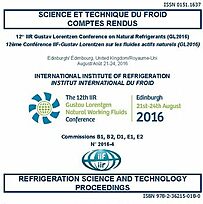
Document IIF
Modéliser les cycles de compression à vapeur à l'aide de pompes à chaleur domestiques fonctionnant au R744 et adaptées au climat hispanique.
Modelling vapour compression cycles with R744 for residential heat pumps adapted to the spanish climate.
Numéro : pap. 1101
Auteurs : PARDIÑAS A. A., BANTLE M., HAFNER A., et al.
Résumé
R744 heat pumps appear as an ideal solution to produce heating, cooling and domestic hot water (DHW). The transcritical cycle has the potential to produce high temperature hot water simultaneously with other demands as heating or air conditioning, however the low trans-critical temperature of CO2 is a natural limitation for applications in warmer climates. R744 heat pumps are now used in Nordic countries, but they are still a challenge for hotter climates, for which there are R&D efforts to enhance their COP. Among the technologies to implement, ejectors appear to improve the cycle performance in percentages that go from 10 to 20%, according to previous works from the literature. This paper details the study of residential heat pumps with R744 to produce combined heating/cooling and DHW under different climatic conditions that occur in Spain. The COP for R744 heat pumps supplying combined heating/cooling and DHW demand is improved by implementing ejectors, however the improvement is not as high as stated in other research studies.
Documents disponibles
Format PDF
Pages : 8 p.
Disponible
Prix public
20 €
Prix membre*
Gratuit
* meilleur tarif applicable selon le type d'adhésion (voir le détail des avantages des adhésions individuelles et collectives)
Détails
- Titre original : Modelling vapour compression cycles with R744 for residential heat pumps adapted to the spanish climate.
- Identifiant de la fiche : 30019063
- Langues : Anglais
- Source : 12th IIR Gustav Lorentzen Conference on Natural Refrigerants (GL2016). Proceedings. Édimbourg, United Kingdom, August 21st-24th 2016.
- Date d'édition : 21/08/2016
- DOI : http://dx.doi.org/10.18462/iir.gl.2016.1101
Liens
- Voir les traductions : Adaptación de los ciclos de compresión de vapor con R744 para bombas de calor domésticas al clima español.
Voir d'autres communications du même compte rendu (140)
Voir le compte rendu de la conférence
Indexation
-
Thèmes :
Pompes à chaleur à usage domestique;
CO2 - Mots-clés : Vapeur; R744; Pompe à chaleur domestique; Performance; Modélisation; Haute température; Compression
-
Feasibility study of various conventional and u...
- Auteurs : YOUNG J., SUBIANTORO A.
- Date : 07/12/2020
- Langues : Anglais
- Source : 14th IIR-Gustav Lorentzen Conference on Natural Refrigerants (GL2020). Proceedings. Kyoto, Japon, December 7-9th 2020.
- Formats : PDF
Voir la fiche
-
Performance evaluation of CO2 HPWH s...
- Auteurs : NAWAZ K., SHEN B., ELATAR A., BAXTER D. van, ABDELAZIZ O.
- Date : 07/12/2020
- Langues : Anglais
- Source : 14th IIR-Gustav Lorentzen Conference on Natural Refrigerants (GL2020). Proceedings. Kyoto, Japon, December 7-9th 2020.
- Formats : PDF
Voir la fiche
-
Modeling and simulation of air-source CO2<...
- Auteurs : GAO Z., RICE K., NAWAZ K.
- Date : 2022
- Langues : Anglais
- Source : 2022 Purdue Conferences. 19th International Refrigeration and Air-Conditioning Conference at Purdue.
- Formats : PDF
Voir la fiche
-
Multi-objective optimization of water tank of c...
- Auteurs : XU Y., LI E., HUANG Y., et al.
- Date : 24/08/2019
- Langues : Anglais
- Source : Proceedings of the 25th IIR International Congress of Refrigeration: Montréal , Canada, August 24-30, 2019.
- Formats : PDF
Voir la fiche
-
Comparison of an innovative subcooled heat pump...
- Auteurs : MASIP X., ALVAREZ-PINEIRO L., HERVÁS-BLASCO E., NAVARRO-PERIS E., CORBERÁN J. M.
- Date : 11/11/2020
- Langues : Anglais
- Source : X Congreso Ibérico y VIII Congreso Iberoamericano de Ciencias y Técnicas del Frío, CYTEF 2020.
- Formats : PDF
Voir la fiche
